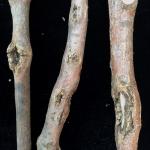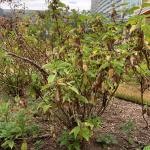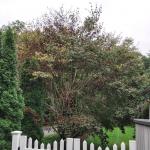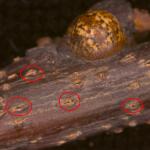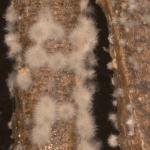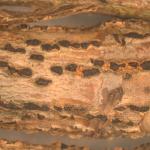Botryosphaeria Canker
Pathogen
Botryosphaeria canker is an important disease of many trees and shrubs in forests and managed landscapes. To date, there are more than two dozen genera in the order Botryosphaeriales that were previously described simply as Botryosphaeria. Some of these genera are known to green industry professionals, such as Diplodia and Sphaeropsis, while many are not. Much remains to be understood about many of these genera and whether they occur on woody plants in southern New England. Therefore, for the purpose of this fact sheet they will be collectively referred to as Botryosphaeria sensu lato (s.l.).
Hosts
Due to the tremendous diversity of genera and species in Botryosphaeria s.l., hundreds of woody plants are susceptible to infection, especially when plant vigor is low. Recent research has shown that only a few species of Botryosphaeria s.l. are host-specific, meaning that many are capable of attacking a wide array of trees and shrubs. However, the most commonly diseased plants in southern New England include apple/crabapple, cherry, dogwood, honeylocust, elm, oak, ash, holly, inkberry, maple, pine, spruce, hemlock, rhododendron and azalea.
Symptoms & Signs
The cambium and sapwood of weakened trees are vulnerable to extensive cankers that disrupt or cease transport of water and minerals beyond the infection site. Typical symptoms are the sudden browning of leaves during the growing season or failure to leaf out in the spring. However, symptoms can be highly variable depending on the host and predisposing stresses present. The extent of Botryosphaeria canker infections can range from: small and isolated areas of necrotic sapwood and bark, girdled shoots and small branches scattered throughout the canopy, extensive branch dieback, and cankering on the main trunk. When infections are severe, woody plants often produce an abundance of water sprouts from the trunk and exhibit discolored and sloughing bark. Lesions may appear sunken and dark in color with oozing sap or resin with wound wood forming on the margins.
Winter injury, drought stress, insect defoliation, transplant shock, root disease, excessive pruning and other physical wounds often predispose trees and shrubs to infection. In general, Botryosphaeria s.l. species behave as opportunistic pathogens that attack weakened and stressed hosts, while in some cases they are primary pathogens of otherwise healthy plants. In addition, many Botryosphaeria s.l. species can survive as endophytes, invading hosts and causing no observable symptoms for long periods of time until plants become stressed. These latent infections can rapidly expand to cause severe dieback on trees and shrubs suffering from transplant shock and drought. Once established in the canopy, the fungus forms small, black-colored fruiting structures (pycnidia and/or pseudothecia) that erupt through the bark. These are often visible with the use of a hand lens blighted twigs and small branches but may be difficult to find on larger diameter branches. Persistent wet weather, primarily during the spring, facilitates spore dispersal by running/splashing rainwater and wind. Other means of spore dispersal include insect feeding and, less frequently, the use of contaminated pruning tools. Spores will germinate and invade any wounds or natural openings present in the bark. The fungus overwinters within infected and dead branches in the canopy or those that have fallen to the ground.
Management
As with any opportunistic pathogen, minimizing stresses that predispose woody plants to infection is critical. Avoid excessive pruning, especially on recently transplanted trees and shrubs. Irrigate on regular intervals during extended dry periods to minimize drought stress, fertilize if soil mineral levels are inadequate, maintain a layer of well-composted organic mulch over the root zone to retain soil moisture and limit mechanical wounds (e.g. string trimmers) and avoid needles branch, stem, and root damage. Regular sanitation pruning should take place, especially for trees and shrubs with thin bark (e.g. beech, Japanese maple, dogwood), to remove low-level infections that may be present in the canopy. Avoid pruning during wet periods in the spring as this is the time period when the fungus is most actively sporulating and sanitize pruning tools after working with plants known or suspected of being infected by Botryosphaeria canker.
Pruning of cankered stems and branches, at least 6-12 inches away from the blighted tissue (if possible), and removal of the diseased material from the site is the best management practice. Repeated scouting and pruning is often required. However, for large and mature trees and shrubs fungicides may also be helpful in suppressing the pathogen once the infection has been identified. It can be difficult to control cankering fungi like Botryosphaeria with fungicides because the pathogen lives beneath the bark and may be present on branches that show no symptoms of disease. Fungicides registered for use against against Botryosphaeria include: azoxystrobin, boscalid+pyraclostrobin, copper salts of fatty and rosin acids, copper hydroxide, propiconazole, mancozeb, thiophanate-methyl and trifloxystrobin. Applications should made in the spring to protect newly developing tissues from becoming infected before these tissues mature. Chemical control may not be required if the cankered stems can be effectively pruned and removed from the site.


